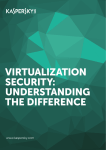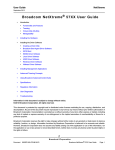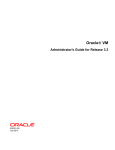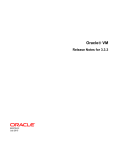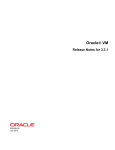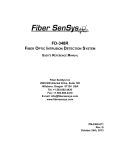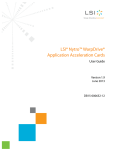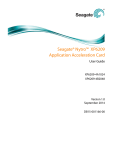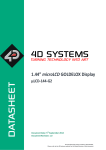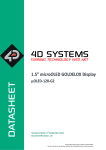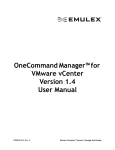Download Managing Multi-Hypervisor Environments with vCenter
Transcript
Managing Multi-Hypervisor Environments with vCenter Server vCenter Server 5.1 vCenter Multi-Hypervisor Manager 1.1 This document supports the version of each product listed and supports all subsequent versions until the document is replaced by a new edition. To check for more recent editions of this document, see http://www.vmware.com/support/pubs. EN-001142-00 Managing Multi-Hypervisor Environments with vCenter Server You can find the most up-to-date technical documentation on the VMware Web site at: http://www.vmware.com/support/ The VMware Web site also provides the latest product updates. If you have comments about this documentation, submit your feedback to: [email protected] Copyright © 2012, 2013 VMware, Inc. All rights reserved. This product is protected by U.S. and international copyright and intellectual property laws. VMware products are covered by one or more patents listed at http://www.vmware.com/go/patents. VMware is a registered trademark or trademark of VMware, Inc. in the United States and/or other jurisdictions. All other marks and names mentioned herein may be trademarks of their respective companies. VMware, Inc. 3401 Hillview Ave. Palo Alto, CA 94304 www.vmware.com 2 VMware, Inc. Contents About Managing Multi-Hypervisor Environments with vCenter Server 5 1 Introduction to Multi-Hypervisor Management in vCenter Server 7 Multi-Hypervisor Management in vCenter Server 8 vCenter Multi-Hypervisor Manager Deployment Schemes 9 vCenter Multi-Hypervisor Manager Software Requirements 9 2 Authorization in vCenter Multi-Hypervisor Manager 11 Minimum Required Privileges to Access the Third-Party Hosts Inventory 11 Assign Permissions to an Object from the Third-Party Hosts Inventory 11 Privileges for Operations on Third-Party Hypervisors 12 Privileges for Creating and Removing Third-Party Virtual Machines 13 Privileges for Power State Operations on Third-Party Virtual Machines 13 Privileges for Configuring Third-Party Virtual Machines 14 Privileges for Converting Third-Party Virtual Machines 15 3 Managing Third-Party Hypervisors 17 Add a Hyper-V Host 17 View Hyper-V Host Configuration 18 Disconnecting and Reconnecting a Hyper-V Host 19 Disconnect a Hyper-V Host 19 Reconnect a Hyper-V Host 19 Shut Down or Reboot a Hyper-V Host 20 Remove Hyper-V Hosts from Inventory 20 4 Creating Virtual Machines on Hyper-V Hosts 21 Start the Virtual Machine Creation Process 22 Configure Virtual Machine Name and Location 22 Configure Virtual Machine Memory Resources 22 Configure Networking 23 Configure Virtual Machine Disk 23 Create a New Virtual Disk 24 Select an Existing Virtual Disk 24 Select an Option for Installing a Guest Operating System Select an Operating System Installation Media 25 Complete the Virtual Machine Creation 25 25 5 Managing Virtual Machines on Hyper-V Hosts 27 Virtual Machine Power State Operations on Hyper-V Hosts Power On a Virtual Machine 28 Power Off a Virtual Machine 28 VMware, Inc. 27 3 Managing Multi-Hypervisor Environments with vCenter Server Suspend a Virtual Machine 28 Changing Virtual Machine Configuration 28 Edit Memory Resources Allocated to Virtual Machine 29 Edit CPU Resources Allocated to a Virtual Machine 30 Edit Floppy Drive of a Virtual Machine 30 Edit Hard Disk Recourses Allocated to a Virtual Machine 31 Edit Network Adapter Connection of a Virtual Machine 31 Edit Virtual Machine CD-ROM or DVD Drive Configuration 32 Adding a Virtual Machine Device 32 Remove a Virtual Machine 36 6 Converting Third-Party Virtual Machines 37 Converting Third-Party Virtual Machines by Using the vSphere Client Convert a Third-Party Virtual Machine Running Windows 38 Convert a Third-Party Virtual Machine Running Linux 39 37 7 Troubleshooting vCenter Multi-Hypervisor Manager 41 Collect the vCenter Multi-Hypervisor Manager Log Bundle 41 Unable to Log In to vCenter Server 41 Index 43 4 VMware, Inc. About Managing Multi-Hypervisor Environments with vCenter Server Managing Multi-Hypervisor Environments with vCenter Server provides information about how to manage thirdparty hypervisors in vCenter Server by using VMware vCenter Multi-Hypervisor Manager. Managing Multi-Hypervisor Environments with vCenter Server also provides information about how to create and manage virtual machines on third-party hypervisors. Intended Audience This information is intended for vSphere system administrators who want to manage third-party hypervisors by using vCenter Server. VMware Technical Publications Glossary VMware Technical Publications provides a glossary of terms that might be unfamiliar to you. For definitions of terms as they are used in VMware technical documentation, go to http://www.vmware.com/support/pubs. VMware, Inc. 5 Managing Multi-Hypervisor Environments with vCenter Server 6 VMware, Inc. Introduction to Multi-Hypervisor Management in vCenter Server 1 When you install and configure the vCenter Multi-Hypervisor Manager server and plug-in, the vCenter Multi-Hypervisor Manager inventory view becomes available in the vSphere Client. From it, you can perform various management operations on your third-party hosts and virtual machines. For more information about how to set up your vSphere Client for multi-hypervisor management, see Installing and Configuring vCenter Multi-Hypervisor Manager. This chapter includes the following topics: n “Multi-Hypervisor Management in vCenter Server,” on page 8 n “vCenter Multi-Hypervisor Manager Deployment Schemes,” on page 9 n “vCenter Multi-Hypervisor Manager Software Requirements,” on page 9 VMware, Inc. 7 Managing Multi-Hypervisor Environments with vCenter Server Multi-Hypervisor Management in vCenter Server If you use heterogeneous types of hypervisors to build your virtual environment, you can use vCenter Multi-Hypervisor Manager to manage both VMware and third-party hypervisors such as Microsoft Hyper-V in vCenter Server. Figure 1-1. vCenter Multi-Hypervisor Manager Components vSphere Client vCenter Multi-Hypervisor Manager Plug-In vCenter Server vCenter Multi-Hypervisor Manager Extension Hyper-V ESX/ ESXi ESX/ ESXi vCenter Multi-Hypervisor Manager Server Hyper-V Hyper-V 8 Third-Party Hypervisor A hypervisor developed by a vendor different than VMware. With vCenter Multi-Hypervisor Manager 1.1 you can manage Microsoft Hyper-V hypervisors. See “vCenter Multi-Hypervisor Manager Software Requirements,” on page 9 for details. vCenter MultiHypervisor Manager Server A component that enables the management of third-party hypervisors in vCenter Server. The vCenter Multi-Hypervisor Manager server can reside on the same machine as vCenter Server if it runs on a Windows OS, or on a remote machine. vCenter MultiHypervisor Manager Plug-In The client component of vCenter Multi-Hypervisor Manager. It is installed as a plug-in to the vSphere Client and provides the graphical interface for managing third-party hypervisors in the vSphere Client. Third-Party Hosts Inventory An inventory tree in vCenter Server where you can manage third-party hypervisors. When installed and configured, vCenter Multi-Hypervisor Manager provides the third-party hosts inventory. You can access the third-party hosts inventory by clicking the vCenter Multi-Hypervisor Manager icon under Inventory in the vSphere Client. You can add third-party hypervisors to the third-party hosts inventory and perform management tasks such as create new virtual machines, change the power state of virtual machines, change the hardware and software configuration of virtual machines, and others. VMware, Inc. Chapter 1 Introduction to Multi-Hypervisor Management in vCenter Server vCenter Multi-Hypervisor Manager Deployment Schemes You can install the vCenter Multi-Hypervisor Manager server on the same machine as vCenter Server if it runs on a Windows OS, or on a remote machine. In both cases, the vCenter Multi-Hypervisor Manager server communicates with the vSphere Client through the vCenter Server proxy. Figure 1-2. Communication Between the vCenter Multi-Hypervisor Manager Server and the vSphere Client Is Established Through the vCenter Server Proxy HTTPS (HTTP tunnel)/80 HTTP/80 vCenter Server Proxy HTTP 8088 vSphere Client HTTPS 8090 vCenter Multi-Hypervisor Manager Server If you decide to install the vCenter Multi-Hypervisor Manager server and vCenter Server on separate machines, verify that the vCenter Server system has network access to the machine where you want to install the vCenter Multi-Hypervisor Manager server and that firewalls do not block the communication between the vCenter Server system and the vCenter Multi-Hypervisor Manager server. vCenter Multi-Hypervisor Manager Software Requirements To manage third-party hypervisors with vCenter Multi-Hypervisor Manager, verify that your environment meets the software requirements for installing and running the vCenter Multi-Hypervisor Manager server and plug-in. To clone virtual machines from Hyper-V hosts to ESX/ESXi hosts, you need access to a system where a supported version of vCenter Converter Standalone server is installed and running. To communicate with vCenter Converter Standalone, vCenter Multi-Hypervisor Manager requires TCP/IP network connection. The vCenter Converter Standalone must be installed in client-server mode so that the vCenter Multi-Hypervisor Manager can connect to it over TCP/IP network. For more information on how to perform a client-server installation of vCenter Converter Standalone, see the VMware vCenter Converter Standalone User's Guide. Table 1-1. Software Requirements for vCenter Multi-Hypervisor Manager Virtual Environment Component Software Requirements vCenter Server systems vCenter Server 5.1.x Third-party hypervisors n n n n n vCenter Multi-Hypervisor Manager server VMware, Inc. Microsoft Hyper-V Server 2012 Microsoft Hyper-V for Windows Server 2012 Microsoft Hyper-V Server 2008 R2 Microsoft Hyper-V for Windows Server 2008 R2 Microsoft Hyper-V for Windows Server 2008 The Windows operating systems that vCenter Server 5.1 supports. For a list of the supported Windows operating systems, see the VMware Compatibility Guide at http://www.vmware.com/resources/compatibility/search.p hp?deviceCategory=software&testConfig=17 9 Managing Multi-Hypervisor Environments with vCenter Server Table 1-1. Software Requirements for vCenter Multi-Hypervisor Manager (Continued) Virtual Environment Component Software Requirements vCenter Multi-Hypervisor Manager plug-in The Windows operating systems that the vSphere Client 5.1 supports. For a list of the supported Windows operating systems, see the VMware Compatibility Guide at http://www.vmware.com/resources/compatibility/search.p hp?deviceCategory=software&testConfig=17 vCenter Converter Standalone server vCenter Converter Standalone 5.1 vCenter Multi-Hypervisor Manager Operational Limits vCenter Multi-Hypervisor Manager can manage up to 50 third-party hypervisors with up to 1,000 virtual machines running. 10 VMware, Inc. Authorization in vCenter Multi-Hypervisor Manager 2 vCenter Multi-Hypervisor Manager integrates with the vCenter Server authorization mechanism. You can associate roles with user accounts for objects from the third-party hosts inventory. This chapter includes the following topics: n “Minimum Required Privileges to Access the Third-Party Hosts Inventory,” on page 11 n “Assign Permissions to an Object from the Third-Party Hosts Inventory,” on page 11 n “Privileges for Operations on Third-Party Hypervisors,” on page 12 n “Privileges for Creating and Removing Third-Party Virtual Machines,” on page 13 n “Privileges for Power State Operations on Third-Party Virtual Machines,” on page 13 n “Privileges for Configuring Third-Party Virtual Machines,” on page 14 n “Privileges for Converting Third-Party Virtual Machines,” on page 15 Minimum Required Privileges to Access the Third-Party Hosts Inventory To access the third-party hosts inventory, you must be able to log in to vCenter Server. Your user account must have at least the Ready-Only role assigned on the vCenter Server root folder. The Ready-Only role has the System.View and System.Read privileges. Any other custom-defined or system role has these privileges as well. If your user account has the Read-Only or any other role assigned on the root folder of the vCenter Server system, you can log in to vCenter Server and access the third-party hosts inventory. If your account has the No Access role or any other role without the System.View and System.Read privileges assigned on the root folder of the vCenter Server system, you cannot log in to vCenter Server and access the third-party hosts inventory. Assign Permissions to an Object from the Third-Party Hosts Inventory You can assign roles to user accounts for objects that are in the third-party hosts inventory tree. Prerequisites n The vSphere Client must be connected to the vCenter Server system. n Required privileges: Permissions.Modify permissions Procedure 1 VMware, Inc. In the vSphere Client, select Home > Inventory > vCenter Multi-Hypervisor Manager. 11 Managing Multi-Hypervisor Environments with vCenter Server 2 From the third-party hosts inventory tree, select the object to which you want to assign permissions, and select the Permissions tab. 3 Right-click within the tab and select Add Permission. 4 To associate a user with the inventory object, click Add in the Users and Groups pane. 5 Select a user or group. a From the Domain drop-down menu, select a domain where the user or group is located. b Type a name in the Search box or select a name from the list. The system searches user names, group names, and descriptions. c Double-click the user or group name. The name is added to the Users or Groups list. 6 d (Optional) Click Check Names to verify that the user or group exists in the database. e Click OK. From the drop-down menu in the Assign Role pane, select a role. The privileges of the role are listed in the section below the role title. 7 (Optional) Deselect Propagate to Child Objects. The role is applied only to the selected object and does not propagate to the child objects. 8 Click OK. The server adds the permission to the list of permissions that the user has for the object. The list of permissions references all users and groups that have roles assigned for the object, and indicates where in the vCenter Server hierarchy the role is assigned. Privileges for Operations on Third-Party Hypervisors To perform operations such as add a third-party hypervisor in vCenter Server, or change the power state of a third-party hypervisor, your user account must have sufficient privileges on the relevant level of the thirdparty hosts inventory. Table 2-1. Operations on Third-Party Hosts Operation Privilege Required on Inventory Level Add a third-party hypervisor Host.Inventory.Add standalone host The root of the third-party hosts inventory. Host.Configuration.Connection The third-party hypervisor Reconnect a third-party hypervisor Disconnect a third-party hypervisor Reboot a third-party hypervisor Shut down a third-party hypervisor Remove a third-party hypervisor 12 Host.Configuration.Maintenance Host.Inventory.Remove host The third-party hypervisor The third-party hypervisor VMware, Inc. Chapter 2 Authorization in vCenter Multi-Hypervisor Manager Privileges for Creating and Removing Third-Party Virtual Machines To create or remove a third-party virtual machine, your user account must have sufficient privileges. Depending on the properties of the new virtual machine, the required privileges vary. Table 2-2. Creating and Removing Third-Party Virtual Machines Privilege Required on Inventory Level Create a new virtual machine Virtual machine.Inventory.Create new The third-party host Create the virtual machine with a disk Datastore.Allocate space The third-party host Create the virtual machine connected with the local network Network.Assign network Create the virtual machine with a new disk Virtual machine.Configuration.Add new disk Create the virtual machine with an existing disk Virtual machine.Configuration.Add existing disk Create the virtual machine with a virtual ethernet card, or with a virtual DVD or CD-ROM for guest OS installation Virtual machine.Configuration.Add or remove device Remove a virtual machine Virtual machine.Inventory.Remove Operation The third-party host The third-party host The third-party host The third-party host The third-party virtual machine Privileges for Power State Operations on Third-Party Virtual Machines To change the power state of a third-party virtual machine, you must have sufficient permissions on the virtual machine object. Table 2-3. Virtual Machine Power State Operations Required on Inventory Level Operation Privilege Power on a virtual machine Virtual machine.Interaction.Power On The third-party virtual machine Power off a virtual machine Virtual machine.Interaction.Power Off The third-party virtual machine Suspend a virtual machine Virtual machine.Interaction.Suspend The third-party virtual machine Reset a virtual machine Virtual machine.Interaction.Reset The third-party virtual machine Shut down the guest OS of a virtual machine Virtual machine.Interaction.Power Off The third-party virtual machine VMware, Inc. 13 Managing Multi-Hypervisor Environments with vCenter Server Privileges for Configuring Third-Party Virtual Machines To change the configuration of a third-party virtual machine, you must have sufficient permissions on the virtual machine object. Table 2-4. Reconfiguring Third-Party Virtual Machines 14 Required on Inventory Level Operation Privilege Rename a virtual machine. Virtual machine.Configuration.Rename The third-party virtual machine Edit virtual machine devices. Virtual machine.Configuration.Modify device settings The third-party virtual machine Edit virtual machine CPU resources. Virtual machine.Configuration.Change CPU count The third-party virtual machine Edit virtual machine memory resources. Virtual machine.Configuration.Memory The third-party virtual machine Edit the resource allocation for a virtual machine's processors, such as weight, reservation, and limit. Virtual machine.Configuration.Change resource Edit the size of a virtual disk. Virtual machine.Configuration.Extend virtual disk The third-party virtual machine Edit a virtual DVD/CD-ROM device configuration. Virtual machine.Interaction.Configure CD media The third-party virtual machine Edit a virtual floppy device configuration. Virtual machine.Interaction.Configure floppy media The third-party virtual machine Remove a virtual disk. Virtual machine.Configuration.Remove disk The third-party virtual machine Remove a physical disk from the virtual machine. Virtual machine.Configuration.Raw device The third-party virtual machine Remove a virtual DVD or CD-ROM, floppy device, or a virtual adapter. Virtual machine.Configuration.Remove device The third-party virtual machine Add or remove DVD or CD-ROM, floppy device, or a virtual adapter. Virtual machine.Configuration.Add or remove device The third-party virtual machine Add a physical disk to the virtual machine. Virtual machine.Configuration.Raw device The third-party virtual machine Add existing disk. Virtual machine.Configuration.Add existing disk The third-party virtual machine Add a virtual disk. Virtual machine.Configuration.Add new disk The third-party virtual machine Add a virtual disk. Datastore.Allocate space Add or reconfigure a network adapter. Network.Assign network The parent third-party host The third-party virtual machine VMware, Inc. Chapter 2 Authorization in vCenter Multi-Hypervisor Manager Privileges for Converting Third-Party Virtual Machines To clone a virtual machine from the third-party host inventory to the inventory of an ESX/ESXi host, your vCenter Server user account must have sufficient privileges. You need to be able to perform operations and access objects on the source third-party host, on the target ESX/ESXi host, and on the target datastore. Privileges on the Source Location On the virtual machine object level on the third-party host, you need the VirtualMachine.Provisioning.GetVMFiles privilege. Additionally, you might need access to a user account with administrator privileges on the guest operating system of the source virtual machine. For more information, see the VMware vCenter Converter Standalone User's Guide. Privileges on the Target Location On the target location, you need all the privileges required to perform vCenter Converter Standalone tasks. For a complete list of such privileges, see the VMware vCenter Converter Standalone User's Guide. VMware, Inc. 15 Managing Multi-Hypervisor Environments with vCenter Server 16 VMware, Inc. Managing Third-Party Hypervisors 3 To simplify the management of virtual environments that have VMware ESX or ESXi hosts and third-party hypervisors such as Microsoft Hyper-V, you can connect your third-party hypervisors to a vCenter Server system by using vCenter Multi-Hypervisor Manager. After you connect your VMware and third-party hypervisors to vCenter Server, you can use the vSphere Client to manage your entire virtual environment. vCenter Multi-Hypervisor Manager 1.1 supports the management of Microsoft Hyper-V hypervisors in vCenter Server. From the third-party hosts inventory of the vSphere Client, you can view the Hyper-V hosts configuration, and perform management tasks such as power off, reboot, disconnect, reconnect, and remove the host from the third-party hosts inventory. n Add a Hyper-V Host on page 17 You can add Hyper-V hosts to vCenter Server, and manage both Microsoft Hyper-V and VMware hypervisors from a single interface. n View Hyper-V Host Configuration on page 18 You can review the Hyper-V host configuration from the vSphere Client to reconfigure some of the Hyper-V settings. n Disconnecting and Reconnecting a Hyper-V Host on page 19 You can disconnect and reconnect a Hyper-V host that vCenter Server manages. vCenter Server stops performing monitoring activities for a disconnected Hyper-V host. n Shut Down or Reboot a Hyper-V Host on page 20 You can shut down or reboot the Hyper-V hosts in your third-party hosts inventory. Shutting down a Hyper-V host disconnects it from vCenter Server, but does not remove it from the inventory. n Remove Hyper-V Hosts from Inventory on page 20 You can remove Hyper-V hosts that you no longer need to manage from your third-party hosts inventory. Removing a managed Hyper-V host from vCenter Server removes the managed host and all its associated virtual machines from the vCenter Server inventory. Add a Hyper-V Host You can add Hyper-V hosts to vCenter Server, and manage both Microsoft Hyper-V and VMware hypervisors from a single interface. Prerequisites n Verify that the vCenter Multi-Hypervisor Manager server is installed and running. For more information, see Installing and Configuring vCenter Multi-Hypervisor Manager. n Verify that the vCenter Multi-Hypervisor Manager plug-in is installed in the vSphere Client. For more information, see Installing and Configuring vCenter Multi-Hypervisor Manager. VMware, Inc. 17 Managing Multi-Hypervisor Environments with vCenter Server n Verify that the vSphere Client is connected to the vCenter Server system. n Verify that the Hyper-V host is configured for remote management with the Windows Remote Management service. n To use an HTTPS connection with the host, enable WinRM over HTTPS on the Windows Remote Management service. n Verify that you have a user account with administrative privileges on the Hyper-V host. n Required privileges: Host.Inventory.Add standalone host. Procedure 1 In the vSphere Client, select Home > Inventory > vCenter Multi-Hypervisor Manager. 2 Right-click the vCenter Server system and select Add Third-Party Host. 3 On the Connection Settings page, type the connection settings for the Hyper-V host, and click Next. a In the Connection pane, type the IP address or the host name. To use an SSL-encrypted connection with the Hyper-V host, type https://IP address or host name. If the Windows Remote Management service on the Hyper-V host is configured with a non-default port, add this port to the host address. b In the Authorization pane, type the credentials of the administrator account for the host. If you have configured WinRM to use HTTP connection with the Hyper-V host, a confirmation dialog appears to warn you about establishing a nonsecure connection with the host. 4 Review the Hyper-V host summary and click Next. 5 In the Ready to Complete page, click Finish. The Hyper-V host is added to the vCenter Server system and appears in the inventory. View Hyper-V Host Configuration You can review the Hyper-V host configuration from the vSphere Client to reconfigure some of the Hyper-V settings. Prerequisites Verify that the vSphere Client is connected to the vCenter Server system. Procedure 1 In the vSphere Client, select Home > Inventory > vCenter Multi-Hypervisor Manager. 2 From the third-party hosts inventory, select a Hyper-V host. 3 Click the Configuration tab. You can review the following information about the configuration of the Hyper-V host. 18 Option Description Processors Displays information about the model of the processor, the processor speed, the number of processor sockets, the number of processor cores per socket, and the number of logical processors. Also displays information about manufacturer, model, BIOS version, and release date. Memory Displays information about the physical memory of the Hyper-V host. VMware, Inc. Chapter 3 Managing Third-Party Hypervisors Option Description Networking Displays information about the virtual switches the Hyper-V host uses. Network Adapters Displays information about the physical network adapter devices on the Hyper-V host. Disconnecting and Reconnecting a Hyper-V Host You can disconnect and reconnect a Hyper-V host that vCenter Server manages. vCenter Server stops performing monitoring activities for a disconnected Hyper-V host. Disconnect a Hyper-V Host Disconnect a managed Hyper-V host to temporarily suspend all vCenter Server monitoring and management activities for the host. The managed Hyper-V host and its associated virtual machines remain in the vCenter Server inventory. Prerequisites n Verify that the vSphere Client is connected to the vCenter Server system. n Required privileges: Host.Configuration.Connection Procedure 1 In the vSphere Client, select Home > Inventory > vCenter Multi-Hypervisor Manager. 2 Right-click a Hyper-V host and select Disconnect. 3 In the confirmation dialog box, click Yes. The managed Hyper-V host disconnects from vCenter Server, the disconnected designation is appended to its name in parentheses, and the label is dimmed. Labels of all virtual machines on the host are similarly dimmed and labeled. Reconnect a Hyper-V Host A Hyper-V host that a vCenter Server system manages might disconnect from vCenter Server because of network problems or other reasons. If this happens, you can reconnect the Hyper-V host. Prerequisites n Verify that the vSphere Client is connected to the vCenter Server system. n Required privileges: Host.Configuration.Connection Procedure 1 In the vSphere Client, select Home > Inventory > vCenter Multi-Hypervisor Manager. 2 Right-click the disconnected host and select Connect. When the host reconnects to vCenter Server, the states of the virtual machines on that host are updated to reflect the change. VMware, Inc. 19 Managing Multi-Hypervisor Environments with vCenter Server Shut Down or Reboot a Hyper-V Host You can shut down or reboot the Hyper-V hosts in your third-party hosts inventory. Shutting down a HyperV host disconnects it from vCenter Server, but does not remove it from the inventory. Prerequisites n Verify that the vSphere Client is connected to the vCenter Server system. n Required privileges: Host.Configuration.Maintenance Procedure 1 In the vSphere Client, select Home > Inventory > vCenter Multi-Hypervisor Manager. 2 From the third-party hosts inventory, select a Hyper-V host. 3 Shut down all virtual machines that are not configured to shut down automatically when the Hyper-V host shuts down or restarts. 4 Right-click the Hyper-V host and select the appropriate option. n Select Reboot, if you want to restart the Hyper-V host. n Select Shut Down, if you want to shut down the Hyper-V host. You cannot power on a Hyper-V host from vCenter Multi-Hypervisor Manager client. 5 In the confirmation dialog box, click Yes. Remove Hyper-V Hosts from Inventory You can remove Hyper-V hosts that you no longer need to manage from your third-party hosts inventory. Removing a managed Hyper-V host from vCenter Server removes the managed host and all its associated virtual machines from the vCenter Server inventory. Prerequisites n Verify that the vSphere Client is connected to the vCenter Server system. n Required privileges: Host.Inventory.Remove host. Procedure 1 In the vSphere Client, select Home > Inventory > vCenter Multi-Hypervisor Manager. 2 From the third-party hosts inventory, right-click the Hyper-V host and select Remove. 3 In the confirmation dialog box, click Yes to remove the Hyper-V host. vCenter Multi-Hypervisor Manager removes the Hyper-V host and all associated virtual machines from the vCenter Server inventory. 20 VMware, Inc. Creating Virtual Machines on Hyper-V Hosts 4 Virtual machines are a key component in a virtual environment. You can create virtual machines on Hyper-V hosts that are connected to vCenter Server. When you create a new virtual machine on a Hyper-V host in vCenter Server, you associate it with the thirdparty hosts inventory. After you power on the virtual machine, it consumes resources dynamically as the workload increases, and returns them as the workload decreases. Every Hyper-V virtual machine has virtual devices that provide the same function as physical hardware. A virtual machine gets CPU, memory, storage, and network connectivity from its Hyper-V host. 1 Start the Virtual Machine Creation Process on page 22 To start the virtual machine creation, you open the Create New Virtual Machine wizard from a HyperV host. 2 Configure Virtual Machine Name and Location on page 22 When you create a third-party virtual machine, you provide a name for it and specify a location for the virtual machine files on the Hyper-V host. 3 Configure Virtual Machine Memory Resources on page 22 The amount of memory that you can allocate for a virtual machine is the amount of memory that the guest operating system detects. 4 Configure Networking on page 23 You can configure a networking connection to the virtual machine so it can communicate with other network nodes, such as Hyper-V hosts, devices, and virtual machines. 5 Configure Virtual Machine Disk on page 23 You can provide a storage space for a virtual machine by attaching a virtual disk. You can reuse an existing virtual disk or create a new one. 6 Select an Option for Installing a Guest Operating System on page 25 You can install a guest operating system from an installation media or from a network-based installation server. 7 Complete the Virtual Machine Creation on page 25 The Ready to Complete page lets you review the configuration selections that you made for the virtual machine. You can change the existing settings, configure resources, networking, and more. VMware, Inc. 21 Managing Multi-Hypervisor Environments with vCenter Server Start the Virtual Machine Creation Process To start the virtual machine creation, you open the Create New Virtual Machine wizard from a Hyper-V host. Prerequisites n Verify that the vSphere Client is connected to the vCenter Server system. n Verify that you have privileges to create third-party virtual machines, listed in “Privileges for Creating and Removing Third-Party Virtual Machines,” on page 13. Procedure 1 In the vSphere Client, select Home > Inventory > vCenter Multi-Hypervisor Manager. 2 Right-click a Hyper-V host and select New Virtual Machine. The Create New Virtual Machine wizard opens. What to do next Configure the virtual machine name and location. Configure Virtual Machine Name and Location When you create a third-party virtual machine, you provide a name for it and specify a location for the virtual machine files on the Hyper-V host. Procedure 1 On the Name and Location page of the Create New Virtual Machine wizard, type a name for the virtual machine in the Name text box. 2 In the Location pane, select a location for the virtual machine. 3 Option Description Use default location Leave this option selected to use the default location for storing virtual machine files on the Hyper-V host. Specify location Type a new location for storing the files of the new virtual machine. For example, C:\Virtual Machines\My Virtual Machine Click Next. What to do next Configure the memory resources for the virtual machine. Configure Virtual Machine Memory Resources The amount of memory that you can allocate for a virtual machine is the amount of memory that the guest operating system detects. Typically, the minimum amount of memory that a virtual machine needs is at least 512MB depending on the guest operating system that you install. The maximum amount of memory that you should allocate to a virtual machine is equal to or less than the physical memory of its host. Procedure 1 22 On the Memory page of the Create New Virtual Machine wizard, select the amount of memory to allocate for the virtual machine. VMware, Inc. Chapter 4 Creating Virtual Machines on Hyper-V Hosts 2 Click Next. What to do next Select a network adapter for the virtual machine. Configure Networking You can configure a networking connection to the virtual machine so it can communicate with other network nodes, such as Hyper-V hosts, devices, and virtual machines. Procedure 1 On the Network Type page of the Create New Virtual Machine wizard, select a network adapter from the Type drop-down list. Option Description No Adapter Leaves the virtual machine without networking. Legacy Network Adapter Allows network boot, but might lead to slower performance. Network Adapter Provides better performance, but might require installing additional guest OS drivers. This adapter type does not support network boot. The additional drivers are provided by the integration services for the guest OS. Newer versions of the supported Windows guest operating systems include the integration services by default. For all other supported guest operating systems, you must install the integration services separately. 2 In the Network Connection pane, select a virtual network from the Network Label drop-down list. 3 Click Next. What to do next Configure the virtual machine disk. Configure Virtual Machine Disk You can provide a storage space for a virtual machine by attaching a virtual disk. You can reuse an existing virtual disk or create a new one. Procedure 1 2 On the Select a Disk page of the Create New Virtual Machine wizard, select an option for attaching a disk to the virtual machine. Option Description Create a new virtual disk Create a new disk and attach it to the virtual machine. Use an existing virtual disk Reuse an existing disk that is configured with an operating system or other virtual machine data. Create a disk later Attach a virtual disk later. Click Next. What to do next If you decide to create a new disk, configure its properties. If you decide to use an existing disk, select its location. To create the virtual machine without disk, review the virtual machine details and create it. VMware, Inc. 23 Managing Multi-Hypervisor Environments with vCenter Server Create a New Virtual Disk You can create a new virtual disk and attach it to the virtual machine. You can create a disk with an amount of space that is allocated for the virtual machine, or a disk with dynamic space allocation. Procedure 1 On the Create a New Disk page of the Create New Virtual Machine wizard, type a name for the new virtual disk. 2 In the Capacity pane, select the disk size. 3 In the Disk Provisioning pane, select the disk provisioning type. 4 5 Option Description Allocate and commit space on demand (Dynamic) The disk uses only as much storage space as it needs. If the disk needs more space, it can grow to the maximum capacity allocated to it. Allocate all disk space now (Fixed) The storage space allocated to the disk is reserved for this disk only. On the Location pane, select an option for the virtual disk location. Option Description Use default storage Use the default virtual disks location on the Hyper-V host. Specify a datastore Type a custom location for the virtual disk on the Hyper-V host. For example, C:\MyVirtualMachines\VirtualMachineDisks\ Click Next. What to do next Select an option for installing a guest operating system on the virtual machine. Select an Existing Virtual Disk For a new virtual machine, you can use an existing disk that is configured with an operating system or other virtual machine data. This choice lets you migrate the virtual hard drive from virtual machine to virtual machine. Procedure 1 On the Select Existing Disk page of the Create New Virtual Machine wizard, type the location of a virtual disk that already exists on the Hyper-V host. For example, C:\Users\Public\Documents\Hyper-V\Virtual hard disks\myVM.vhd 2 Click Next. What to do next Review the details of the virtual machine and create it. 24 VMware, Inc. Chapter 4 Creating Virtual Machines on Hyper-V Hosts Select an Option for Installing a Guest Operating System You can install a guest operating system from an installation media or from a network-based installation server. Procedure 1 2 On the Operating System Installation page of the Create New Virtual Machine wizard, select an option for installing a guest operating system on the virtual machine. Option Description Install an operating system later Install an operating system after the new virtual machine is created. Install an operating system from a bootable CD/DVD-ROM or a floppy disk Use a bootable media to install the guest operating system. Install an operating system from a network-based installation server Use a network-based installation of the guest operating system. To use this option, you must have configured the virtual machine with a legacy network adapter. Click Next. What to do next The selected option for installing the guest operating system determines the next step: n Select an installation media. n Complete the virtual machine creation process. Select an Operating System Installation Media You can install the guest operating system on the virtual machine by using a physical CD or DVD drive, an ISO image, or a floppy image. Procedure 1 2 On the Installation Media page of the Create New Virtual Machine wizard, select the media. Option Description Physical CD/DVD drive Map a physical CD or a DVD drive to the virtual machine where the installation media is loaded. Image file (.iso) Type the location of an ISO image stored on the Hyper-V host. Floppy image (.vfd) Type the location of the floppy image file stored on the Hyper-V host. Click Next. What to do next Review the details for the virtual machine and create it. Complete the Virtual Machine Creation The Ready to Complete page lets you review the configuration selections that you made for the virtual machine. You can change the existing settings, configure resources, networking, and more. Procedure 1 VMware, Inc. On the Ready to Complete page of the Create New Virtual Machine wizard, review the configuration settings for the virtual machine. 25 Managing Multi-Hypervisor Environments with vCenter Server 2 (Optional) To change the virtual machine settings, go back through the pages of the wizard and change the settings as necessary. 3 Click Finish to complete the virtual machine creation. The new virtual machine appears in the third-party hosts inventory. What to do next Before you can use the new virtual machine, install a guest operating system, and install integration services if needed. 26 VMware, Inc. Managing Virtual Machines on HyperV Hosts 5 You can use the vSphere Client to manage all virtual machines on Hyper-V hosts that are in the third-party hosts inventory. To manage Hyper-V hosts through your vCenter Server system, you must have vCenter Multi-Hypervisor Manager server installed on your system and the vCenter Multi-Hypervisor Manager plug-in installed in the vSphere Client. You can power on, power off, and suspend the virtual machines on a Hyper-V host. Power state operations can be useful when you want to perform maintenance tasks on your Hyper-V host. You can also enhance virtual machine performance by adding new virtual devices or modifying the existing ones. n Virtual Machine Power State Operations on Hyper-V Hosts on page 27 The ability to change virtual machine power states is useful when you perform maintenance on the Hyper-V host or want to reconfigure the virtual machine hardware devices. n Changing Virtual Machine Configuration on page 28 You can reconfigure some virtual machine properties after you create the virtual machine and install a guest operating system. n Remove a Virtual Machine on page 36 You can remove virtual machines that you no longer need to see in the third-party hosts inventory. Virtual Machine Power State Operations on Hyper-V Hosts The ability to change virtual machine power states is useful when you perform maintenance on the Hyper-V host or want to reconfigure the virtual machine hardware devices. You can power on, power off, suspend, and reset virtual machines on Hyper-V hosts. Power On Powers on a stopped virtual machine, or resumes a virtual machine from a suspended power state. If no operating system is installed, you can install an operating system on a powered on virtual machine. Power Off Powers off a virtual machine. You can update the virtual hardware settings on a powered off virtual machine. Suspend Pauses all virtual machine activity. You can power on the virtual machine later to run all paused activities. Reset Shuts down and restarts a virtual machine. This power state operation is similar to resetting a physical machine by pressing its reset button. Any programs running on the virtual machine might be disrupted. VMware, Inc. 27 Managing Multi-Hypervisor Environments with vCenter Server Power On a Virtual Machine You can power on a stopped or suspended virtual machine on a Hyper-V host from the third-party hosts inventory in the vSphere Client. Prerequisites n Verify that the vSphere Client is connected to the vCenter Server system. n Required privilege: Virtual machine.Interaction.Power On n Before you power on a virtual machine, verify that the Hyper-V host has sufficient resources. The sum of all virtual machines memory must not exceed the Hyper-V memory. You must have enough memory for the virtual machine, and some memory overhead. Procedure 1 In the vSphere Client, select Home > Inventory > vCenter Multi-Hypervisor Manager. 2 On the Hyper-V host, right-click a virtual machine and select Power On. Power Off a Virtual Machine You can power off a virtual machine on a Hyper-V host to edit its configuration settings. Prerequisites n Verify that the vSphere Client is connected to the vCenter Server system. n Required privileges: Virtual machine.Interaction.Power Off Procedure 1 In the vSphere Client, select Home > Inventory > vCenter Multi-Hypervisor Manager. 2 In the third-party hosts inventory, right-click a virtual machine and select Power Off. Suspend a Virtual Machine You can suspend a running virtual machine to free CPU or memory on a Hyper-V host. Prerequisites n Verify that the vSphere Client is connected to the vCenter Server system. n Required privileges: Virtual machine.Interaction.Suspend Procedure 1 In the vSphere Client, select Home > Inventory > vCenter Multi-Hypervisor Manager. 2 In the vSphere Client inventory, right-click a virtual machine and select Suspend. The virtual machine is suspended. Changing Virtual Machine Configuration You can reconfigure some virtual machine properties after you create the virtual machine and install a guest operating system. When you create a virtual machine, the hardware properties you set correspond to the physical resources available on the Hyper-V host where the virtual machine resides. The virtual machine hardware includes memory configuration, CPU configuration, hard disk size, available network adapters, and so on. 28 VMware, Inc. Chapter 5 Managing Virtual Machines on Hyper-V Hosts Table 5-1. Virtual Machine Hardware Hardware Device Description Memory The size of the virtual hardware memory determines how much memory is available to applications that are running inside the virtual machine. A virtual machine cannot benefit from more memory resources than its configured virtual hardware memory size. CPU You can configure a virtual machine that runs on a Hyper-V host to have one or more virtual processors. A virtual machine cannot have more virtual CPUs than the actual number of logical CPUs on the host. You can change the number of CPUs allocated to a virtual machine and configure the CPU resource allocation. Floppy Drive You can connect to a floppy (.flp) image only. You can add, remove, or configure a floppy device. Hard Disk Stores the guest operating system, program files, and other data associated with the activities of the virtual machine. A virtual disk is a large physical file, or a set of files, that can be copied, moved, archived, and backed up. You can add physical hard drives for a pass-through to a virtual machine. The hard disk on the Hyper-V host must be enabled for pass-through. Network Adapter Network adapters provide network connectivity between the virtual machines on the same host, between virtual machines on different hosts, and between other virtual and physical machines. When you configure a virtual machine, you can add network adapters (NICs) and set the adapter type. CD/DVD Drive You can configure DVD and CD-ROM devices to connect to host devices or ISO files on a datastore. You can view and configure the virtual machine hardware and add or remove devices from a virtual machine. Edit Memory Resources Allocated to Virtual Machine You can add or change the memory resources of a virtual machine to enhance its performance. The memory resource setting determines how much of the host memory is allocated to a virtual machine. Prerequisites n Verify that the vSphere Client is connected to the vCenter Server system. n Required privileges: Virtual machine.Configuration.Memory n Power off the virtual machine. Procedure 1 From the third-party hosts inventory, right-click a powered off virtual machine and select Edit Settings. The Virtual Machine Properties dialog box appears. 2 3 VMware, Inc. On the Hardware tab, select Memory. n To change the amount of memory allocated to the virtual machine, use the slider or type a value in the Memory Size text box. n To select the predefined default or recommended setting, click the colored triangles on the right-hand side of the memory bar. Click OK to save your changes. 29 Managing Multi-Hypervisor Environments with vCenter Server Edit CPU Resources Allocated to a Virtual Machine You can change or configure CPU resources to improve virtual machine performance. You can change CPU resource allocation settings, such as weight, reservation, and limit so that the available resource capacity meets your needs and the resources are balanced among your virtual machines. Prerequisites n Verify that the vSphere Client is connected to the vCenter Server system. n Verify that the virtual machine is powered off. n Required privileges: Virtual machine.Configuration.Change CPU count and Virtual machine.Configuration.Change resource Procedure 1 From the third-party hosts inventory, right-click a powered off virtual machine and select Edit Settings. The Virtual Machine Properties dialog box appears. 2 On the Hardware tab, select CPUs. 3 Select a number from the Number of virtual processors drop-down menu. 4 In the Resource Allocation pane, allocate the CPU allocation for the virtual machine. 5 Option Description Weight Defines how the Hyper-V host allocates resources to this virtual machine when running virtual machines compete for resources. Reservation Defines the percentage of CPU capacity that is reserved for the virtual machine. This setting guarantees CPU allocation for the virtual machine. Limit Defines the upper limit that can be used by the virtual machine from the CPU capacity available to the virtual machine. Click OK to save your changes. Edit Floppy Drive of a Virtual Machine You can configure a virtual floppy device to connect to an existing floppy image. Prerequisites n Verify that the vSphere Client is connected to the vCenter Server system. n Power off the virtual machine. n Required privileges: Virtual machine.Interaction.Configure floppy media Procedure 1 From the third-party hosts inventory, right-click a powered off virtual machine and select Edit Settings. The Virtual Machine Properties dialog box appears. 30 2 On the Hardware tab, select Floppy Drive. 3 In the Device Type pane, select Use existing floppy image in datastore and provide the path to the floppy image in the text box. 4 Select the option to create a new floppy image if one does not exist. 5 Click OK. VMware, Inc. Chapter 5 Managing Virtual Machines on Hyper-V Hosts Edit Hard Disk Recourses Allocated to a Virtual Machine You can change the virtual device node to which a virtual machine hard disk is assigned for better performance. Prerequisites n Verify that the vSphere Client is connected to the vCenter Server system. n Power off the virtual machine. n Required privileges: Virtual machine.Configuration.Modify device settings Procedure 1 From the third-party hosts inventory, right-click a powered off virtual machine and select Edit Settings. The Virtual Machine Properties dialog box appears. 2 On the Hardware tab, select a hard disk from the virtual machine hardware devices. 3 From the Virtual Device Node drop-down menu, select the virtual device node where you want the hard disk to appear. 4 Review the Disk Provisioning pane and click OK. The virtual disk is assigned to the selected IDE or SCSI controller. Edit Network Adapter Connection of a Virtual Machine You can change the MAC address and the network connection for a virtual machine's virtual network adapter. Prerequisites n Verify that the vSphere Client is connected to the vCenter Server system. n Power off the virtual machine. n Required privileges: Network.Assign network Procedure 1 From the third-party hosts inventory, right-click a powered off virtual machine and select Edit Settings. The Virtual Machine Properties dialog box appears. 2 On the Hardware tab, select Network Adapter from the virtual machine hardware devices. 3 Select an option for MAC address configuration. 4 5 VMware, Inc. Option Description Automatic A MAC address is assigned automatically. Manual Type the MAC address for the virtual machine. In the Network Connection pane, select an option from the Network label drop-down menu. Option Description Disconnected Disconnect the network adapter. Local Area Connection - Virtual Network Select the port group for the virtual NIC to connect to. Click OK. 31 Managing Multi-Hypervisor Environments with vCenter Server Edit Virtual Machine CD-ROM or DVD Drive Configuration You can connect the virtual machine DVD or CD-ROM device to a physical DVD or CD-ROM device that resides on the host. Prerequisites n Verify that the vSphere Client is connected to the vCenter Server system. n Power off the virtual machine. n Required privileges: Virtual machine.Interaction.Configure CD media Procedure 1 From the third-party hosts inventory, right-click a powered off virtual machine and select Edit Settings. The Virtual Machine Properties dialog box appears. 2 On the Hardware tab, select CD/DVD Drive. 3 In the Device Type pane, select a device type: Option Description Host Device From the Host Device drop-down menu, select a device. Datastore ISO File In the Datastore ISO File text box, type the filepath to a .iso file that you want the virtual machine to use for a CD-ROM or DVD drive. 4 From the Virtual Device Node drop-down menu, select the node that the drive uses in the virtual machine. 5 Click OK. Adding a Virtual Machine Device You can add hardware resources to existing virtual machines to increase the available virtual disk space, the number of DVD or CD-ROM devices, or the number of NICs the virtual machine uses. Add a DVD or CD-ROM Drive You can configure virtual DVD or CD-ROM devices to connect to a physical device on the host or to an ISO file. Prerequisites n Verify that the vSphere Client is connected to the vCenter Server system. n Power off the virtual machine. n Required privileges: Virtual machine.Configuration.Add or remove device Procedure 1 From the third-party hosts inventory, right-click a powered off virtual machine and select Edit Settings. The Virtual Machine Properties dialog box appears. 2 On the Hardware tab, click Add. The Add Hardware wizard opens. 3 32 On the Device Type page, select CD/DVD Drive and click Next. VMware, Inc. Chapter 5 Managing Virtual Machines on Hyper-V Hosts 4 From the CD/DVD Media Type page, select an option and click Next. Option Action Use a physical drive In the Select CSD/DVD Drive page, select the drive you want to use from the drop-down menu, and click Next. Use ISO image In the Select ISO Image page, type the path and filename for the image file, and click Next. 5 On the Advanced Options page, select the virtual device node for the drive and click Next. 6 Review the Ready to Complete page and click Finish. 7 In the Virtual Machine Properties dialog box, click OK to apply the changes. Add a Network Adapter You can add network adapters to a virtual machine so that it can communicate with other nodes on the virtual network. Every network adapter is connected to one of the virtual networks of the Hyper-V host. Prerequisites n Verify that the vSphere Client is connected to the vCenter Server system. n Power off the virtual machine. n Required privileges: Virtual machine.Configuration.Add or remove device and Network.Assign network Procedure 1 From the third-party hosts inventory, right-click a powered off virtual machine and select Edit Settings. The Virtual Machine Properties dialog box appears. 2 On the Hardware tab, click Add. The Add Hardware wizard opens. 3 On the Device Type page, select Network Adapter and click Next. 4 In the Adapter Type pane, select a network adapter type from the Type drop-down menu. Option Description Network Adapter Provides better performance, but requires additional guest operating system drivers. This adapter does not support network boot. Additional drivers are available in the integration services for the guest operating system. Newer versions of the supported Windows guest operating systems include the integration services by default. For all other supported guest operating systems, you must install the integration services separately. Legacy Network Adapter Allows network boot, but might lead to slower performance. The legacy network adapter is not supported on the 64-bit edition of Windows Server 2003. 5 In the Network Connection pane, select a virtual network from the Network Label drop-down list. 6 Click Next. 7 Review the Ready to Complete page and click Finish. 8 In the Virtual Machine Properties dialog box, click OK to apply the changes. VMware, Inc. 33 Managing Multi-Hypervisor Environments with vCenter Server Add a New Virtual Disk You can create and add a new virtual disk to increase the available space on a virtual machine. Prerequisites n Verify that the vSphere Client is connected to the vCenter Server system. n Required privileges: Virtual machine.Configuration.Add new disk and Datastore.Allocate space n Power off the virtual machine. Procedure 1 From the third-party hosts inventory, right-click a powered off virtual machine and select Edit Settings. The Virtual Machine Properties dialog box appears. 2 On the Hardware tab, click Add. The Add Hardware wizard opens. 3 On the Device Type page, select Hard Disk and click Next. 4 On the Select a Disk page, select Create a new virtual disk from the options for attaching a disk to the virtual machine. 5 On the Create a Disk page, type a name for the new virtual disk in the Name pane. 6 In the Capacity pane, type a size for the disk and from the Disk Size drop-down menu, select a disk size in Megabytes, Gigabytes, or Terabytes. 7 In the Disk Provisioning pane, select the disk provisioning type. 8 Option Description Allocate and commit space on demand (Dynamic) The disk uses only as much storage space as it needs. If the disk needs more space, it can grow to the maximum capacity allocated to it. Allocate all disk space now (Fixed) The storage space allocated to the disk is reserved for this disk only. On the Location pane, select an option for the virtual disk location. Option Description Use default storage Use the default virtual disks location on the Hyper-V host. Specify a datastore Type a custom location for the virtual disk on the Hyper-V host. For example, C:\MyVirtualMachines\VirtualMachineDisks\ 9 Click Next. 10 On the Advanced Options page, select the virtual device node from the Virtual Device Node drop-down menu. 11 Review the Ready to Complete page and click Finish. 12 In the Virtual Machine Properties dialog box, click OK to apply the changes. Add an Existing Virtual Disk You can add an existing virtual disk to increase the available space on a virtual machine. Prerequisites n 34 Verify that the vSphere Client is connected to the vCenter Server system. VMware, Inc. Chapter 5 Managing Virtual Machines on Hyper-V Hosts n Power off the virtual machine. n Required privileges: Virtual machine.Configuration.Add existing disk and Datastore.Allocate space Procedure 1 From the third-party hosts inventory, right-click a powered off virtual machine and select Edit Settings. The Virtual Machine Properties dialog box appears. 2 On the Hardware tab, click Add. The Add Hardware wizard opens. 3 On the Device Type page, select Hard Disk and click Next. 4 On the Select a Disk page, select Use an existing virtual disk from the options for attaching a disk to the virtual machine. 5 On the Select Existing Disk page, type a location for the virtual disk that already exists on the Hyper-V host. For example, C:\Users\Public\Documents\Hyper-V\Virtual hard disks\myVM.vhd 6 On the Advanced Options page, select the virtual device node from the Virtual Device Node drop-down menu. 7 Review the Ready to Complete page and click Finish. 8 In the Virtual Machine Properties dialog box, click OK to apply the changes. Add a Physical Hard Disk You can add physical hard drives for a pass-through to a virtual machine. Prerequisites n Verify that the vSphere Client is connected to the vCenter Server system. n Verify that the virtual machine is powered off. n Required privileges: Virtual machine.Configuration.Raw device Procedure 1 From the third-party hosts inventory, right-click a powered off virtual machine and select Edit Settings. The Virtual Machine Properties dialog box appears. 2 On the Hardware tab, click Add. The Add Hardware wizard opens. 3 On the Device Type page, select Hard Disk and click Next. 4 Select Pass-through to a physical drive on the host and click Next. 5 Select a physical hard drive and click Next. 6 Select a SCSI or an IDE virtual device node for the hard drive and click Next. 7 Review the properties for adding the physical disk and click Finish. 8 In the Virtual Machine Properties dialog box, click OK to save your changes. VMware, Inc. 35 Managing Multi-Hypervisor Environments with vCenter Server Remove a Virtual Machine You can remove virtual machines that you no longer need to see in the third-party hosts inventory. Removing a virtual machine from the third-party hosts inventory unregisters it from the Hyper-V host and vCenter Server. Virtual machine files remain at the same storage location on the Hyper-V host. Prerequisites n Verify that the vSphere Client is connected to the vCenter Server system. n Power off the virtual machine. n Required privileges: Virtual machine..Inventory..Remove Procedure 1 In the vSphere Client, select Home > Inventory > vCenter Multi-Hypervisor Manager. 2 Right-click the virtual machine and select Remove. 3 In the confirmation dialog box, click Yes. vCenter Server removes references to the virtual machine and no longer tracks its condition. 36 VMware, Inc. Converting Third-Party Virtual Machines 6 For maintenance, extended management options, or improved performance, you can convert a virtual machine from a third-party host to a virtual machine on an ESX/ESXi host managed by your vCenter Server. To perform virtual machine conversions with vCenter Multi-Hypervisor Manager in the vSphere Client, you need to have configured a vCenter Converter Standalone server while installing the vCenter Multi-Hypervisor Manager server. This chapter includes the following topics: n “Converting Third-Party Virtual Machines by Using the vSphere Client,” on page 37 n “Convert a Third-Party Virtual Machine Running Windows,” on page 38 n “Convert a Third-Party Virtual Machine Running Linux,” on page 39 Converting Third-Party Virtual Machines by Using the vSphere Client After you install and configure vCenter Multi-Hypervisor Manager for virtual machine conversions, you can use the vSphere Client to hot clone virtual machines from a third-party host to an ESX/ESXi host that your vCenter Server manages. vCenter Multi-Hypervisor Manager does not provide the conversion feature but simply exposes the conversion capabilities of vCenter Converter Standalone in the vSphere Client. Setting Up the vSphere Client to Convert Third-Party Virtual Machines While installing the vCenter Multi-Hypervisor Manager server, you need to provide the connection details and the authentication credentials for the vCenter Converter Standalone server that you want to use for virtual machine conversions. After you install both the vCenter Multi-Hypervisor Manager server and plug-in, the convert feature becomes available for objects in the third-party hosts inventory tree in the vSphere Client. For more information about how to install and set up vCenter Multi-Hypervisor Manager, see Installing and Configuring vCenter Multi-Hypervisor Manager. Hot Cloning by Using the vSphere Client Hot cloning, also called live cloning or online cloning, is a cloning process where the source machine remains powered on and its guest operating system remains running. A new virtual machine is created on the target destination and its virtual disks are populated with cloned data from the source virtual machine. Because processes continue to run on the source machine during the conversion, the resulting virtual machine is not an exact copy of the source machine. VMware, Inc. 37 Managing Multi-Hypervisor Environments with vCenter Server You can use the vSphere Client to initiate and configure hot cloning conversion tasks for virtual machines in the third-party hosts inventory tree, but the vCenter Multi-Hypervisor Manager server and the vCenter Converter Standalone server handle the conversion job. All vCenter Converter Standalone conversion limitations apply to conversions initiated in the vSphere Client. For more information about how vCenter Converter Standalone carries out conversion jobs and what the conversion limitations are, see the VMware vCenter Converter Standalone User's Guide. Conversion Sources and Destinations For the conversion process you need a source machine to convert to a destination object. Source A source, also called a conversion source or a source virtual machine, is any powered on virtual machine that is selected for conversion from the third-party hosts inventory tree. You can convert only virtual machines that are listed as supported sources in the VMware vCenter Converter Standalone User's Guide. Destination A destination, also called a destination virtual machine, is the new virtual machine created on the ESX or ESXi host you have selected during the conversion setup. You can convert sources only to virtual machines listed as managed destinations in the VMware vCenter Converter Standalone User's Guide. The destination virtual machine is not an exact copy of the source virtual machine. You might need to perform additional manual reconfiguration after the conversion is complete. Convert a Third-Party Virtual Machine Running Windows After installing and configuring vCenter Multi-Hypervisor Manager, you can use the vSphere Client to convert virtual machines that run a Windows operating system on a third-party host to a virtual machine that run a Windows operating system on an ESX/ESXi host. All such conversions are subject to the requirements and limitations of the vCenter Converter Standalone server you have decided to use. Prerequisites n Verify that you have set up a vCenter Converter Standalone server for virtual machine conversions. n Verify that the third-party virtual machine is powered on. n Verify that the virtual machine meets all conversion requirements listed in the VMware vCenter Converter Standalone User's Guide. n Verify that the vSphere Client is connected to the vCenter Server system. n Required privileges: VirtualMachine.Provisioning.GetVMFiles Procedure 1 In the vSphere Client, select Home > Inventory > vCenter Multi-Hypervisor Manager. 2 In the third-party hosts inventory tree, right-click the virtual machine that you want to convert and click Convert. The Convert VM wizard opens. 38 VMware, Inc. Chapter 6 Converting Third-Party Virtual Machines 3 On the Source virtual machine page, provide information about the third-party virtual machine you are attempting to convert and click Next. If integration services are installed on the source, the vCenter Multi-Hypervisor Manager server populates the Address text box and selects the type of the guest operating system. Option Description User name Type the user name for an administrator account for the guest operating system of the virtual machine. Password Type the password for the administrator account for the guest operating system of the virtual machine. Address If not populated automatically or populated with an incorrect value, type the IP address or the fully qualified domain name of the virtual machine. OS Type If not selected automatically or selected incorrectly, select Windows. The vCenter Multi-Hypervisor Manager server authenticates with the guest operating system of the source and verifies that the vCenter Converter Standalone agent is already installed on the source virtual machine. For more information about the vCenter Converter Standalone agent and how it is involved in the conversion of a virtual machine running Windows, see the VMware vCenter Converter Standalone User's Guide. 4 If the Confirm encrypted connection pop-up window appears, review and accept the SSL certificate thumbprint. The Confirm encrypted connection pop-up window appears if the vCenter Converter Standalone agent is already installed on the source machine. 5 On the Name and Location Page, type a name for the destination virtual machine, select the datacenter where you want to place the destination virtual machine, and click Next. If you use folders in your virtual environment to manage groups of virtual machines, you can select a folder to accommodate the destination virtual machine. 6 On the Select Host page, select the target ESX or ESXi host that will manage the destination virtual machine and click Next. 7 On the Select Storage page, select the datastore where you want to store the files of the destination virtual machine and click Next. 8 Review the Ready to Complete page and click Finish. The destination virtual machine is added to the selected host in the selected datacenter. The power state of the destination virtual machine is Powered Off. Convert a Third-Party Virtual Machine Running Linux After installing and configuring vCenter Multi-Hypervisor Manager, you can use the vSphere Client to convert virtual machines that run a Linux operating system on a third-party host to a virtual machine that run a Linux operating system on an ESX/ESXi host. All such conversions are subject to the requirements and limitations of the vCenter Converter Standalone server you have decided to use. Prerequisites n Verify that you have set up a vCenter Converter Standalone server for virtual machine conversions. n Verify that the third-party virtual machine is powered on. n Verify that the virtual machine meets all conversion requirements listed in the VMware vCenter Converter Standalone User's Guide. n Verify that the vSphere Client is connected to the vCenter Server system. VMware, Inc. 39 Managing Multi-Hypervisor Environments with vCenter Server n Required privileges: VirtualMachine.Provisioning.GetVMFiles Procedure 1 In the vSphere Client, select Home > Inventory > vCenter Multi-Hypervisor Manager. 2 In the third-party hosts inventory tree, right-click the virtual machine that you want to convert and click Convert. The Convert VM wizard opens. 3 On the Source virtual machine page, provide information about the third-party virtual machine you are attempting to convert and click Next. If integration services are installed on the source, the vCenter Multi-Hypervisor Manager server populates the Address text box and selects the type of the guest operating system. Option Description User name Type the user name for an administrator account for the guest operating system of the virtual machine. Password Type the password for the administrator account for the guest operating system of the virtual machine. Address If not populated automatically or populated with an incorrect value, type the IP address or the fully qualified domain name of the virtual machine. OS Type If not selected automatically or selected incorrectly, select Linux. 4 In the Confirm encrypted connection pop-up window, review the SSH key fingerprint and click OK to confirm the identity of the source virtual machine. 5 On the Name and Location Page, type a name for the destination virtual machine, select the datacenter where you want to place the destination virtual machine, and click Next. If you use folders in your virtual environment to manage groups of virtual machines, you can select a folder to accommodate the destination virtual machine. 6 On the Select Host page, select the target ESX or ESXi host that will manage the destination virtual machine and click Next. 7 On the Select Storage page, select the datastore where you want to store the files of the destination virtual machine and click Next. 8 Review the Ready to Complete page and click Finish. The destination virtual machine is added to the selected host in the selected datacenter. The power state of the destination virtual machine is Powered Off. 40 VMware, Inc. Troubleshooting vCenter Multi-Hypervisor Manager 7 The troubleshooting vCenter Multi-Hypervisor Manager topics provide solutions to problems that you might encounter when using vCenter Multi-Hypervisor Manager. n Collect the vCenter Multi-Hypervisor Manager Log Bundle on page 41 VMware Technical Support might request the vCenter Multi-Hypervisor Manager log bundle to help resolve technical issues. You can generate a log bundle as a file. n Unable to Log In to vCenter Server on page 41 You might be unable to log in to vCenter Server and access the third-party hosts' inventory tree. Collect the vCenter Multi-Hypervisor Manager Log Bundle VMware Technical Support might request the vCenter Multi-Hypervisor Manager log bundle to help resolve technical issues. You can generate a log bundle as a file. VMware Technical Support routinely requests diagnostic information from you when a support request is addressed. This diagnostic information contains product specific logs and configuration files from the host on which the product is run. This information is gathered using a specific script or tool within the product. For technical issues related to converting third-party virtual machines, you might need to provide the vCenter Converter Standalone log bundle. For more information how to obtain the bundle, see the VMware vCenter Converter Standalone User's Guide. Procedure 1 Browse to the installation directory of the vCenter Multi-Hypervisor Manager server. The default installation directory is C:\Program Files\VMware\Infrastructure\VMware vCenter MHM. 2 Double-click the mhm-support.bat file. The log files are saved as a .zip file in the vCenter Multi-Hypervisor Manager installation directory. Unable to Log In to vCenter Server You might be unable to log in to vCenter Server and access the third-party hosts' inventory tree. Problem You cannot log in to vCenter Server and access the third-party hosts' inventory tree. The following error message appears: The vSphere Client could not connect to vCenter Server address. You do not have permission to login to the server: vCenter Server address VMware, Inc. 41 Managing Multi-Hypervisor Environments with vCenter Server Cause Your user account has the No-Access role assigned on the root folder of vCenter Server or has no role assigned at all. Solution Assign at least the Read-Only role to your user account on the root folder of the vCenter Server system. 42 VMware, Inc. Index A H add host Hyper-V host 17 third-party host 17 assigning permissions 11 authorization 11 host disconnect 19 reconnect 19 Hyper-V host configuration 18 reboot 20 shut down 20 Hyper-V hosts remove 20 remove from inventory 20 supported versions 9 C cannot log in 41 cloning virtual machines destinations 37 Linux 39 privileges 15 sources 37 system requirements 9 Windows 38 converting virtual machines destinations 37 Linux 39 privileges 15 sources 37 Windows 38 create third-party virtual machine, install operating system 25 create virtual machine complete creation 25 configure memory 22 configure networking 23 configure virtual disk 23 create new disk 24 networking 23 OS installation 25 OS installation media 25 select existing disk 24 start virtual machine creation 22 virtual machine location 22 virtual machine name 22 I installing deployment 9 software requirements 9 system requirements 9 L logs collect 41 generate bundle 41 M manage Hyper-V host 17 third-party host 17 third-party hypervisors 17 managing Hyper-V host 17 third-party host 17 third-party hypervisors 17 multi-hypervisor environments 7, 8 multi-hypervisor management, overview 7 N no access 41 D O deploying, vCenter Multi-Hypervisor Manager 9 disconnecting Hyper-V hosts 19 third-party hosts 19 P operating system installation 25 operational limits 9 permissions 11 power state 27 VMware, Inc. 43 Managing Multi-Hypervisor Environments with vCenter Server privileges add device 14 add host 12 clone virtual machines 15 convert virtual machines 15 create virtual machine 12 disconnect host 12 edit CPU resources 14 edit memory resources 14 host operations 12 power off virtual machine 13 power on virtual machine 13 reboot host 12 reconfigure virtual machine 12–14 remove host 12 reset virtual machine 13 virtual machine operations 12 R reconnect Hyper-V host 19 reconnecting Hyper-V hosts 19 third-party hosts 19 required privileges 11, 12 roles 11 S system requirements cloning virtual machines 9 Converter Standalone server 9 Hyper-V versions 9 operating system 9 OS 9 third-party hypervisors 9 vCenter Server versions 9 T third-party virtual machine add CD 32 add CD-ROM 32 add DVD 32 add DVD drive 32 add existing virtual disk 34 add network adapter 33 add new virtual disk 34 add virtual disk 34 configuration 28 edit CD 32 edit CD-ROM 32 edit CPU 30 edit DVD 32 edit DVD drive 32 44 edit floppy drive 30 edit hard disk 31 edit memory 29 edit network adapter 31 install operating system 25 install OS 25 power off 27, 28 power on 27, 28 power state operations 27 remove 36 remove from inventory 36 suspend 27, 28 third-party virtual machines add device 32 cloning 37 cloning privileges 15 converting 37 converting privileges 15 privileges to clone 15 privileges to convert 15 running Linux 39 running Windows 38 troubleshooting vCenter Multi-Hypervisor Manager 41 V vCenter Multi-Hypervisor Manager communication ports 9 deployment 9 limitations 9 operational limits 9 virtual machine add hard disk 35 add hard drive 35 add pass-through hard disk 35 add physical hard disk 35 virtual machines cloning 37 cloning Linux 39 cloning Windows 38 converting 37 converting Linux 39 converting Windows 38 running Linux 39 running Windows 38 VMware, Inc.













































